Albert Arthur Allen: forgotten American nudes of the 1920’s.
Born on May 8, 1886, near Grafton, Mass. to a wealthy New England family, Albert Arthur Allen moved to California at the age of 21 and opened the Allen Art Studio in Oakland in 1916.
Nude photography was already considered academic in
Europe by the late 1800’s, and Allen’s work coming decades later was already considered “campy” due in part to its reliance on contrived poses and classical themes. At the dawn of the “Roaring 20’s” artists were expected to be embracing modern revolutions in design, morality and aesthetic; by contrast his early photographs were of girls posing in nature along the
Pacific Coast or simple figure studies directed toward art students.
During the next few years Allen went through a small fortune experimenting with the “scientific obstacles” of
photography. Around 1920 he renamed the studio as “The Allen Institute of Fine and Applied Art” and began teaching photography as well as publishing thematic portfolios of
nudes intended for educational use. He produced a truly prolific body of work: in his introduction to the portfolio “The Female Figure” (1923) he writes “This series, when completed, will cover the subject of the human form in every phase, classified under many units.” Another preface, this time for a “Student Reference Works” claims it to “…contain what is believed to be the most complete work ever complied on such subjects… the studies are miscellaneously arranged, one hundred in each collection”.
Besides his artistic endeavors Allen also studied science- including physiology, chemistry and mechanical engineering: this could partially explain his preferences in an anatomical rather than creative approach in portraying the nude. Indeed, much of the criticism directed towards his work is focused on this almost sterile portrayal of the form. Another body of his work from this decade focuses on models in ordinary domestic settings; and while they are considerably more “creative” the poses still seem contrived as if determined by some geometric theory.
This paradox in Allen’s work has been attributed to a number of factors, ranging from a simple lack of imagination to the general realities of shooting work intended as reference material rather than artistic expressions. So little is actually known about his personal life that one can only speculate, but historian Daile Kaplan believes that Allen envisioned his photos as inspiring a kind of great democratic project; “To see
womankind entirely nude would place all women on equality,” Allen wrote,
“And it would be only their true mental and physical charm that would
lift them from the ordinary…There is, of course, a fine distinction between the non-essential nude
and the true nude. The non-essential nude is a picture which has no
message to speak. While the true nude gives a version of beauty, both
physical and spiritual -two great needs of humanity.”
Again we must delve into the realms of speculation, but it’s probable that Allen was influenced by the Naturism movement which was becoming popular in Europe by the mid 1920’s. Although it wasn’t established in America until the end of the decade, there are striking similarities between Allen’s philosophy and those of European nudists. The age of nudity was to be “a new mental and physical freedom from this age of economic slavery.”
In essence, Allen possibly considered compositional aesthetics to be a secondary concern. The idea that he lacked creative ability is somewhat disingenuous as he was certainly capable of producing hauntingly beautiful imagery.
But despite his idyllic philosophies life was dealing a series of hard blows to the photographer. In 1923 Allen crashed his motorcycle into a streetcar,
crumpling his right leg. After numerous medical procedures his right
hip was fused: a condition that meant his left leg was permanently set
in a sitting position, and he spent the rest of his
life on crutches.
It is interesting to note that in comparison
to the contemporary photography coming from Europe (and especially France), Allen had produced almost nothing which could be considered erotic by anything
beyond the strictest standards. But the so-called “Comstock Laws” that were currently
in effect in America certainly attempted to apply those standards in force: beginning in 1924 Allen was indicted on charges of mailing obscene materials by the “Purity League” and the “Society for the Suppression of Vice.” While he was acquitted in the federal courts on three separate occasions, a fourth trial resulted in his conviction and 6 months of prison.
In his 1925 series “Sex Appeal” he probably comes as close as he ever did to outright salaciousness, unusually depicting the models in stages of undress.
That same year a fire destroyed his studio: Allen founded a new movie studio, Classic Motion Picture Corp.
from the ashes of the Institute with a vision of integrating his still
photography into the new medium of motion pictures, and began choreographing groups of models in
pantomimes and military drills. Kaplan writes that “…the tableaus were conceived and
directed by him, with models who had undergone several months of
hard training, to be able to master certain poses under the correct
anatomical posture.” But the Great
Depression was looming, and the financial support from his family which
he had relied upon until then came to an abrupt halt. He filed
bankruptcy in 1927 and his visions of meticulously choreographed nude films came crashing
down around him.
With his career in shambles and bitter at his failure, he published a series of photos in 1929 based on film “The Sheik” which had been released 8 years earlier: Allen photographed a Valentino impersonator seducing a young woman who at the last moment produces a revolver. Kaplan believes that the set was a symbolic allegory for Allen; the sheik
begins the tableau as “virile,” but by the end “he is reduced to being a
… Christ-like figure.”
One of Allen’s last series is “Premiere Nudes 1930”, a series of group
portraits in which seven models recline in the
background while an eighth poses in the foreground wearing
nothing but shoes. Allen realized that shoes changed a woman’s posture, her “general
line of grace” writing: “The height of the modern heel gives the
feminine figure an entirely different alignment and balance.”
The album was republished in 2001 by Twin Palms Publishers (ISBN-10: 0944092888).
Allen’s final series, “Exotic Nudes” (also published in 1930) are anthropological
studies of “naked women of color.”
On September 6, 1930 Allen was found guilty in his fourth obscenity case. The sentence was eventually reduced to a $1,200 fine and 6 months of probation. He opened a portrait studio on Market Street in San Francisco, and little is known of his life beyond that point. In 1936 he was a
photographer for the Elysium Foundation, a nudist organization. At some
point, he had a son named Frederick, and he died “unknown” in 1962.
In 1979 Paul Cava, a Philadelphia gallery owner, discovered 180
original Allen prints and used them for the first time in a commercial
exhibition: in 1992 Arizona State University mounted the first Allen
retrospective featuring photographs from the collection of Terry
Etherton.
References:
Special thanks to Michelle Kimball for providing reference materials.
Roaring ’20s women: The flappers Albert Arthur Allen photographed wear bobbed hair, high heels and not much else.
Albert Arthur Allen (vintage erotica forums)
Premiere Nudes: Albert Arthur Allen


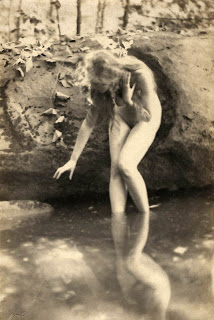







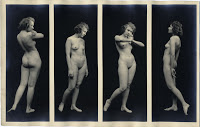






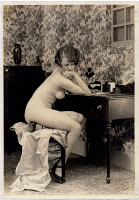



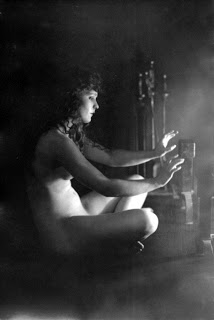
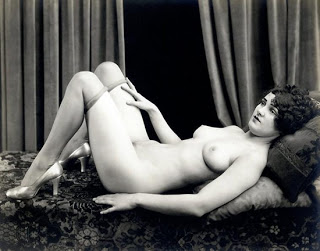

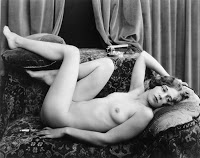






















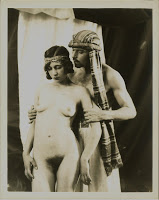










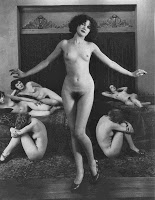







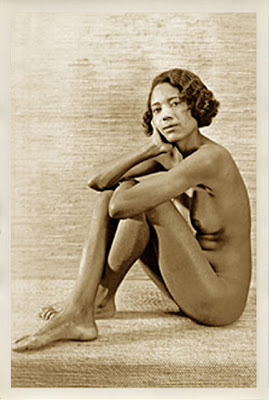
Pictures of Lily
Great page, well researched. Allen also directed the 13 min. nudie short film “Forbidden Daughters” (1927) which was pretty racy for its time. Been trying to find out if he did other films.
I love those pictures! There is a strange charm to them, far far away from any pornography. Thank you!
Lovely~ Look into the past, thank you…;)
Just think, you’re looking at old ladies here
Pronoun trouble: who produces the revolver, the sheikh or the young woman?
All old ladies had youth once, and the same is true for men. If you learn to appreciate their youth, it helps you appreciate their present state.
Love this post.
I am eternally astonished and confurmed in my admiration of the sensual human
This work understands women as: they are within fashion and the constraints of life/textiles & technology; the pure form needs that a model can provide; and an alluring, erotic view of women that we have already seen stripped. This is all very good but should the dark skinned lady (with a very good ‘presentation’) have been made to sit it out until last? He got his exposures right(enough of the time)and he believed
I need someone to contact me who may be interested or have knowledge of someone interested in the missing nude number 10 of part of the alto series call me at 3079202199
Amazing, his photographs are so like ones I have seen recently on modern photographers’ web sites…there is nothing ‘new’! I like his poses because of the languid non sexualised way he arranged his models. He was definitely a Victorian but way ahead of his time also
My father, Frederick Arthur Allen recently passed away leaving me some of my grandfather’s original glass plates along with a few of his oil paintings.
Not sure of their value or historical significance. May also be able to provide some information concerning his later years. I lived with him and my grandmother Genevieve for most of my childhood.
I have a set of 6 sepia photographs by this artist which are landscapes: Yosemite, Monterey & Lake Tahoe. They are clearly signed and dated. They were given to me by my father many years ago and I have no idea of their provenance. I would like some idea of their value for insurance purposes only.
I want to buy one of those!! How do I do that??
Very well researched page here. The models have a type of female beauty that has long since passed. The only disheartening thing is seeing how early in the century that these photos were taken that the unfortunate practice of shaving under the arms had taken such hold. Thank God the mass conversion to the practice of removing pubic hair still had another 70 years or so to come into place.